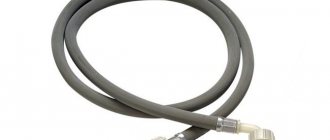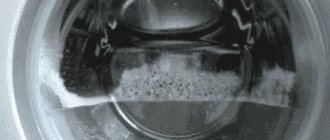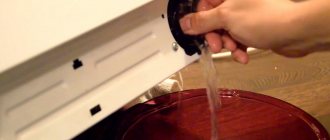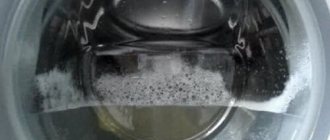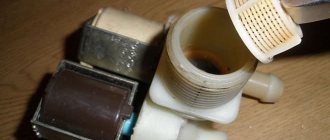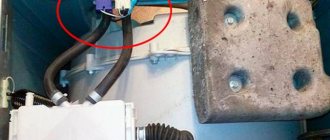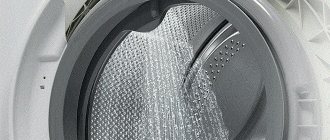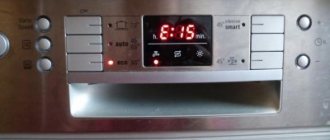machines » The washing machine takes in a lot or little water.
The quality of the wash depends on the addition, draining and replacement of water - if the washing machine takes in little water, the concentration of the powder is disturbed, the laundry turns out to be dry, and this affects the result. The operation of the water supply system is based on the interaction of valves with an electronic control unit, and the command to stop the supply is given by a signal from a sensor - a pressure switch. In case of failures and malfunctions in this chain, the device incorrectly determines the moment when the valve is turned on and off.
The service provider provides repair services for washing machines at home in Moscow and the Moscow region with a prompt visit by a technician.
You can submit a request for service by calling +7 (495) 745-24-00 or using the contact form on our website. We work daily from 8:00 to 23:00, service is provided on weekdays, weekends and holidays. When replacing spare parts in household appliances, a warranty is provided.
The washing machine overfills or does not add water - reasons
There are several malfunctions of washing machines in which the operation of the system for regulating the amount of water in the tank is disrupted. The peculiarity of this system is that it is connected to sewerage and water supply and is not completely independent of external factors. The Samsung, Indesit, Bosch, Candy, LG, Ardo, Zanussi, Electrolux, Beko washing machines provide control of the water level in the tank - based on the information received from the sensor, the electronic unit makes a decision about opening and closing the valve.
What happens if the sensor incorrectly determined the amount of water in the tank, or the control unit did not issue a command in time? The inlet valve may not open or close too late, resulting in either too much water or not enough water to wash properly. But there are several external reasons for such failures.
- Error when connecting to water supply and sewerage.
- Incorrect operation of pressure sensors.
- Control unit malfunction.
- Incorrect operation of the intake valve.
Most often, errors with the amount of water in the washing machine tank are associated with these phenomena.
The machine is not properly connected to the water supply and sewerage system
Even if everything in the machine itself is in good order and works without failures, the water supply and sewage system can affect its execution of the washing program. Let's consider the options and reasons: incorrect connection. When installing a new machine, the drain hose was not placed on the loops provided for it on the body. Water flows freely into it due to the absence of a height difference, is directed into the siphon and goes into the pipes. The washing machine constantly loses water and gets it from the water supply. This leads to loss of dissolved powder and constant additional heating of water, which worsens the quality of washing and significantly increases its time.
If the connection to the water supply is incorrect or the pressure in the pipes is unstable, the washing machine does not add water - the pressure switch does not report the required amount to the control unit, and it does not issue a command to start the program. In some cases, the machine starts to work, but you notice that powder remains in the tray, and the laundry does not get wet immediately. This indicates a slow water build-up and insufficient pressure.
The washing machine takes in a lot of water
Excessive amount of water in the car is also a nuisance. When the tank overfills, excess water begins to flow into the pipes through the drainage hole. If the influx of water is large, then it can leak from the tank onto the floor and flood the neighbors. What is the reason for this behavior of the washing machine?
Faulty pressure switch - water level sensor
The amount of water in the tank is determined by a pressure switch - it measures the pressure at the bottom of the machine and, based on this indicator, makes a conclusion about the amount of water in the tank. It is impossible to focus on the water level, because when the drum rotates, it changes all the time. If the pressure switch malfunctions, the pressure information does not correspond to reality, and the electronic unit issues commands at the wrong time. Then your washing machine overfills or draws too little water.
Intake valve failure
The inlet valve is a membrane that opens upon command from the control unit. A malfunction of the electrical part causes it to shut down - then water will not flow. If the valve is mechanically damaged, the inlet hole will not be fully open or partially open all the time - then the washing machine will either draw water too slowly or overfill. In the first case, washing will take a very long time, in the second, you will pay for the excessive consumption of water and electricity.
The washing machine takes in little water - the pressure switch is faulty
We have already talked about the role of the pressure switch in controlling the washing machine. If this pressure sensor at the bottom of the washing machine tank has a malfunction, then two types of errors are possible - either it considers that the pressure is higher than normal, and the water supply stops, or, according to its data, the pressure is low, and the machine overflows water. The washing machine takes in little water if the pressure switch is faulty, which should be replaced with a new one.
Damaged inlet valve
The most dangerous problem that causes the washing machine to constantly fill with water is a defect in the fill valve, which serves as a barrier between the water supply and the machine mechanism. When the “fill” command is received, the valve opens and liquid begins to be drawn into the powder compartment and further into the tank. When the chamber is full, the signal goes to the control unit, and from it back to the valve, and it closes. If it is broken, that is, it does not block the pipes, moisture will enter the system even when the device is turned off or the hatch is open. If the pressure switch is working properly, the device will drain immediately. If not, the room will be flooded. The only way to stop the flow is to shut off the pipes.
Like the previous element, this valve breaks in different ways. If only the inner membrane is faulty, flow will be weak. It can be replaced. But if the flow is strong and filling occurs quickly, it means that this part cannot be repaired, you need to install another one.
Inlet valve failure occurs in Whirlpool, Bosch and Ardo brands.
The washing machine does not draw water correctly and does not hold water - what should I do?
Since there are several reasons for this behavior of the washing machine, and they have different origins, your action is to eliminate external sources of problems. You can:
- check the presence of water in the water supply by opening the tap in front of the machine;
- make sure that the water purification filter is not clogged;
- if the pressure is unstable, install regulators;
- Check the position of the drain hose and, if necessary, return it to the loops on the back of the machine.
If all these steps lead to nothing, and your washing machine constantly takes in too much or little water, call a service center technician! The fault is inside the machine, which means you cannot fix it.
The control unit has failed
If you notice that the device does not wash clothes in the allotted time, that is, the washing mode increases several times, and at the same time the tank is filled for half an hour, then the rinsing process is delayed, a failure has occurred in the control module, which controls all processes in the device.
This breakdown occurs in Indesit and Hansa machines. Usually the control unit is carefully protected from any deformation, but in the event of a power surge or natural wear and tear, it fails. Manufacturers do not recommend opening it, cleaning contacts or performing unqualified repairs. It would be more correct to install a new part of the same brand, otherwise a software conflict will arise.
Whatever problem occurs with your equipment, the service technicians will help you deal with it. We work any time from 7:00 to 23:00. Call us at number.
Diagnostics and repair of a washing machine - cost and guarantees
In order for the breakdown to be found, it is necessary to diagnose the washing machine at home - start it, make sure that there are problems with the water supply, drain the water and begin disassembling. The technician will have to remove the housing panels to get to the pressure switch and check the condition of the intake valve. Under the top panel, where the information panel is located, there is a control unit - a special device and a set of test commands are used to test it.
The decision to repair is made only after the faulty unit has been clearly identified. If a chain of wear-and-tear faults occurs, the technician will explain the situation to you and offer to replace the necessary parts.
Do not expect to save money by installing substandard spare parts, parts of dubious origin and used ones - this is often offered by various unscrupulous craftsmen who offer to quickly repair a washing machine at a very low price. Do not forget that any manufacturer sets prices for parts and components, below which substandard conditions begin and there is a risk of installing faulty spare parts on the machine.
The cost of repairing a washing machine has a lower limit - it depends on the price of purchasing spare parts. If this limit is exceeded, then there will be no savings, because soon you will have to call a specialist again and pay for repairs. Call specialists from a service center that offers service with guarantees - it’s a matter of your ability to make claims and fix problems.
The water sensor is broken
The most common problem, because the pressure switch that controls the fullness of the tank is vulnerable to any damage. If it is worn out, a signal will always be sent to the control module that the drum is empty.
This part consists of the sensor itself, a pressure tube and an internal elastic membrane. All these elements are fragile and become damaged over time: contacts short out or oxidize inside the sensor, the membrane becomes hard or depressurizes, and the tube may crack. Some argue that all these problems can be solved by repair, but the experience of our specialists says that these measures are enough for 6-9 months of normal operation, and after that the breakdown will return. It is better to install a new pressure switch. For AEG and Miele equipment, it is important that these are original spare parts.
Possible consequences of a malfunction
During operation, the machine can draw water at least twice, since any mode involves the washing process itself, as well as rinsing the laundry. Of course, depending on the selected operating mode, the number of cycles of adding and draining water may increase, which is a normal technological process. Concern should arise when the washing machine constantly fills with water, which is one of the most unpleasant and dangerous breakdowns.
When the drainage system is functioning correctly, the unit will remove water from the tank. But if the drain is clogged, the electronic control may fail or flood the neighboring residents. In addition to economic losses (increased water consumption), this situation leads to a heavy load on the main components and parts of the machine, which causes their premature wear. Especially if the Indesit washing machine constantly takes in water, the heating element suffers, which is connected very often.
In any case, operating a washing machine with uncontrolled filling of water is prohibited, as this may cause damage to other components of the unit.
Reasons for uncontrolled water intake
It is not difficult to notice that the Ariston washing machine constantly fills with water. After collection, the water is constantly drained into the sewer, which is accompanied by the incessant noise of the liquid being removed, and also greatly lengthens the process of washing clothes.
The most common reasons why a washing machine constantly fills with water are:
- Incorrect connection of the washing machine during installation.
- Damage to the filler (inlet) or outlet valve.
- Malfunction of the liquid level sensor (pressostat).
- Failure in the electronic control system.
Incorrect sewer connection
Particular attention should be paid to the correct connection of the washing unit during first installation or after moving the machine to another location.
A reasonable question arises: the washing machine constantly fills with water, what should I do? It is considered that the device is connected correctly if the drain hose is connected to the sewer through a siphon. The working end of the device should be located above the machine drum, i.e. at a height of about 60 cm from the floor surface. This arrangement completely eliminates spontaneous leakage of water from the tank. Otherwise, the Samsung washing machine constantly draws water, since the level sensor is triggered when the water level drops and sends a signal to the pump to pump up liquid. At the same time, the washing cycle increases in time and the quality of work suffers.
Is there a significant risk of water overflow?
Of course, things don’t always end with the formation of lakes in your own bathroom and rain on your neighbors downstairs. After all, most modern washing machines are equipped with special devices that stop the water supply when it reaches a critical level in the drum, followed by draining and stopping the program. But you still need to remember that if there are any other interruptions in the operation of the unit (for example, a clogged drain hose) and there is no protection against leaks (not every model is equipped with it), water from the drum may well migrate onto your tiled floor, and it's even further from there. If you discover such a deficiency, it is better to immediately seek help from a specialist.
We fix the problem ourselves
If your washing machine does not fill water well, this may indicate either a breakdown, an unfortunate coincidence or your own carelessness. Let's look at the main situations in the event of which you can do without calling a specialist.
1.
Low pressure in the water supply
. This is easy to check - open the cold water tap and evaluate the pressure, so to speak, visually. If it's very weak, congratulations, you've found the problem! There are two ways out of this situation:
- Ignore the weak pressure. However, in this case, washing will take a very long time.
- Wait until the water pressure returns to normal. At this time, you can call the utility company and find out about the causes of the malfunction and the timing of its elimination.
2. The shut-off valve is not fully open.
This valve shuts off the water supply to the washing machine. Therefore, if you find that it is not fully open, then all you need to do is move it to the “working” position. It may also be that the tap itself has become unusable - it has stopped or is spinning. In this case, replace it with a working one yourself or by contacting a plumber.
3. The inlet hose is bent.
If there are no problems with water pressure, you should check the supply hose for kinks: perhaps this is why water does not flow well into the washing machine. The situation is easy to correct - straighten the hose and the water supply will be restored.
4. The filler valve strainer installed at the inlet of the washing machine is clogged.
At the point where the inlet hose is connected to the washing machine, there is a filter mesh through which all the water entering the washing machine passes. Due to impurities and small particles contained in tap water, the filter becomes clogged over time and begins to pass water poorly. You can correct the situation as follows:
- Turn off the water supply;
- Unscrew the inlet hose;
- Using pliers, carefully pull the screen out of the inlet valve;
- Clean it with a stiff brush and rinse under strong water. An effective cleaning method is also the “folk” method, in which the filter is immersed in a citric acid solution for 30 minutes. “Limonka” will quickly “eat off” the accumulated plaque, and the filter will be as good as new.
Checking the unit installation
After installing the unit, it is recommended to check that it is installed correctly. The visual method is applicable in rooms where there is free access to the elements of the drainage system.
If it is impossible to control the level of the drain hose due to natural obstacles, you can check the correct installation using an experimental method. To do this, you need to set the normal washing mode and wait until the tank is filled with water. Next, turn on the drain and set a pause after 5-7 seconds.
For some time you need to monitor the liquid level in the tank. If the water level remains at the same level, then the machine is connected correctly. An incorrect connection will be indicated by the characteristic murmur of water in the pipes.
Some tips for proper use
Trouble-free operation of any household device is possible only if the basic rules of its operation are observed. Therefore, experts recommend not to neglect simple tips:
- connect the machine with the help of specialists, according to the manufacturer’s instructions;
- ensure proper loading of laundry;
- add washing powder according to the load rate;
- It is recommended to periodically clean the connecting hoses and the unit filter.
Even though the washing machine operates in automatic mode, it is still not recommended to leave it unattended. The presence of timers and protection systems cannot guarantee the serviceability of the home assistant during a power surge.
Replacing the pressure switch
The level sensor is located on the tank at the rear of the machine. Therefore, to get to it, you will have to remove the cover of the unit. Next, the condition of the sensor contacts is visually assessed, and if there are traces of oxidation, mechanical cleaning is performed.
Self-replacement of the level sensor is carried out according to the following scheme:
- First, the hose going to the compression chamber is disconnected.
- Then, by unscrewing the two screws, remove the pressure switch from the housing, having previously disconnected the terminals of the device.
- We install the new sensor by tightening it with self-tapping screws.
- We connect the power terminals of the device.
- Connect the compression hose.
- We close the case with a protective cover.
Before closing the cover of the unit, you can perform a test run, on the basis of which the issue of serviceability of the system will be decided.
Possible breakdowns
If the above tips did not help fix the problem, and the washing machine still draws water very slowly, then most likely it is a breakdown. Possible breakdowns and their descriptions are given in the table.
| Breaking | Repair or replacement | Repair cost* (labor + spare parts) |
| Intake valve malfunction | Due to a breakdown, the electronic valve that regulates the water supply to the machine does not open completely, and the unit simply “physically” cannot draw enough water. The valve needs to be replaced with a new one. | from 2900 to 7900 rub. |
| Damage to the control module (board) | The situation is the opposite of the one described above. The intake valve does not open because, due to a breakdown, the control module does not issue the required command. The control module needs to be repaired or replaced. | from 3000 rub. |
* The table shows the approximate FULL COST
, including the work of the master and the cost of spare parts. The technician will determine the exact repair estimate after inspecting the washing machine, taking into account the nature of the breakdown, as well as the manufacturer and model of the washing machine.
Sewer blockage
Also, the washing machine constantly draws water if the general sewer is clogged. This siphon effect occurs as a result of the appearance of rarefied pressure when neighbors in the riser use the sewer. This pressure is sufficient for periodic pumping of liquid from the tank of the washing unit.
Installing a special low-power valve (anti-siphon) on the drain hose allows you to get rid of this harmful circumstance.
A temporary preventative measure is to disconnect the drain from the siphon and install it in the bathtub or sink when washing.
Fill valve problem
The solenoid valve also wears out over time and may become stuck open, causing the machine to pour too much liquid into the drum. With this problem, water constantly flows into the tank when the wash has just started or when the rinse begins. The program does not stop running, but an error message may appear on the washing machine screen.
Washing machine fill valve
All that remains is to dismantle the old valve and install a new one, because it cannot be restored. The problem of weak valves can often be observed in models from LG, Samsung and Indesit, apparently due to the fact that many models of these brands have poor control over the level of vibration during rinsing or spinning. For example, Ariston or Ardo have always been more reliable in this regard, as confirmed by consumers. Therefore, if your Samsung washing machine overflows water, immediately dial the technician’s number or contact the service center.
Incorrect operation of the control unit
A washing machine can constantly draw water if the control system, which is responsible for the proper functioning of all components of the unit, fails. In this case, the signals from the control board are sent in the wrong order, which can cause the tank to spontaneously fill with water.
In the event of such a breakdown, an error code is displayed on the control unit display, which allows you to navigate the cause of the malfunction. You can completely restart the control system by turning the unit off and on. If even after such manipulations the washing machine still constantly fills with water, then it is recommended to contact the specialists of the repair center. A malfunction of the control unit is a very big problem, since most often it is necessary to completely change the control board.
